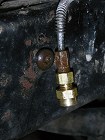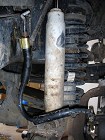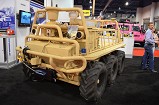I was driving home from the grocery store in the car. After a long day of snowfall, and with the freezing night temperatures, the roads were wonderfully icy and slick. I managed to slide my way home and make a spectacular J-turn into the driveway when I was struck by, what seemed at the time to be, a good idea.
|

|
?Hey,? I thought to myself, ?these are perfect conditions for doing some donuts.? But as any true donut connoisseur will tell you, good donuts just can?t be done in a little front wheel drive commuter car. Truly delicious donuts need to be done in a short wheelbase Jeep. And even better than that, a short wheelbase Jeep in four wheel drive.
But as I was soon to be reminded, like any good thing these tasty treats come at a price.
|
|
So I fire up the Jeep and head out to my local wide open parking lot. The conditions appeared perfect: a slick icy layer covered by a thin coating of freshly fallen powder. I tested the road surface out with a couple rounds in two wheel drive. ?Oh this is gonna be good.? I was thinking. Without wasting any more time, I popped the Jeep into four wheel drive and flipped the lever engaging the rear OX locker. I started out slowly trying to get a good rotation. The goal with the four wheel drive donuts is not to whip the back end around the front, but rather to pivot the Jeep in one spot around a central point right in the middle of the Jeep. The idea is that the circles made in the snow are exactly the size of the Jeeps wheelbase. It?s no easy feat to pull off, but when it works it?s truly spectacular.
|
|
Sure enough, the front end started pulling to one side and the back end to the other. ?It?s working!! This is awesome!!? I was getting a perfect rotation and starting to build up speed. Then??..SNAP!!!! My front tires hit a dry spot. ?Hmmm that doesn?t seem like a good thing.?
|

|
The noise definitely came from the front end of the Jeep, so I quickly stop and exit with flashlight in hand. I checked both U-joints in the axle and closely looked over the driveshaft, but nothing was wrong. I got back into the Jeep and put it in 2wd. It drove forward a few feet and the front end completely locked up. At that instant I knew? Broken ring and pinion. I managed to limp the Jeep back home and parked it for the night.
|

|
The next morning I started pulling the front axle apart. My theory was instantly confirmed when I pulled the front diff cover and pieces of metal fell out into the drip pan. Upon closer inspection, no less than five teeth were broken on the ring gear. I put in an order for a new ring and pinion, but this particular TJ is a daily driver and I needed to get to work for the next week while waiting for the parts. So I did exactly what I would have done if this happened on the trail; the same trail repair I have personally witnessed a dozen times. I pulled the axle shafts and the carrier and bolted the hubs back onto the knuckles and thought nothing of it.
|

|
My ?trail? repair held for an entire day?s commute to work and back. I thought for sure I was going to get through this ordeal with no down time on the Jeep while I waited for my gears. Then the next morning on the way to work everything went straight to hell.
|

|
Slowing down to make a turn in the road, the wheel bearing separated. Since it?s the whole hub assembly that holds the wheel on the front axle, half the wheel bearing bolted to the wheel, the brake rotor, brake caliper, and brake lines all went with it?.. went with it rolling down the road while the right side of the front axle slammed into the ground onto the lower ball joint and dragged to a stop some 30 feet later when it hit the curb.
|

|
|
The natural reaction in this situation is to jam the brake pedal to the floor. But since the brake line was torn off the Jeep and rolling down the road with my front right tire, I lost all brake pressure.
I managed to jack the front axle up over the cub and drive the Jeep off the road onto the dirt. Then of course I called the boss to day ?I?m going to be a little late today, my wheel fell off.? After that I did what anyone writing for a Jeep magazine would do, I stood on the side of the road taking pictures as other motorist drove by wondering just what the **** I was doing.
|

|
|
Fortunately I had an old wheel bearing at home that I swapped onto the Jeep, there in the mud on the side of the road, an limped it home on back roads using the parking brake to stop.
This brings me to the next part of my story: valuable lessons in trail repairs. Upon looking at the failed wheel bearing, I noticed that it?s just two pieces pressed together and the outer axle shaft is actually a structural piece in holding it together. I?m sure a lot of you reading this right now already knew that and would never do what I did, but I also know that a whole bunch of people have limped a Jeep with a broken front axle off the trail and back to town doing the exact same thing I did. I got lucky having my catastrophic failure happen at about 20mph in town. If this happened on the freeway on the way home from Moab, I wouldn?t be here writing this article today.
|

|
I couldn?t just put the axle shafts back in because I didn?t have a carrier in there to hold them. So I took my spare set of front axle shafts and separated them at the U-joint. Then I popped in a new wheel bearing and bolted the outer stub shaft in like normal. This would hold the bearings together without having the inner shafts flopping around tearing up the seals and bearing races. Of course I did this for both sides so the front left wouldn?t fall off too.
|

|
With the wheel back on the Jeep, now I had to worry about the brakes on the right side. It?s not just that the brake line tore off the Jeep. The steering knuckle (which is also the caliper bracket) was broken in two places, so I couldn?t bolt the caliper back onto the axle. Now along with waiting for gears, I had to track down a new (used) right side steering knuckle; and I STILL needed this Jeep as a daily driver to get to work (Those slave driving magazine presidents, you know). I needed to plug the right side brake line.
|
|
I have seen situations of torn brake lines on the trail before. The usual trail repair is to crimp the hard line closed with some Vise-Grips and limp it back to town. This time, however I decided to do something better than the usual Band-Aid repair. That and I didn?t want to replace the hard brake line if I didn?t have to. So I took a trip down to the local House of Hose and picked up a couple fittings.
|

|
One is an adapter to go from the brake line to a ╝? NPT thread. The other is a ╝? NPT cap. With the two fittings, I could cap the brake line on the right side. This would seal much better than smashing the line with some pliers, would allow me to bleed the system, and could easily be removed without damaging the hard line. I will definitely be carrying these with me on the trail from now on.
|

|
Note: You?re probably thinking at this point ?great part, but where do I get it?? I picked it up at a local company in town here, but it should be easy enough for you to do the same. Grab the phone book and look up your local hydraulic hose supply/repair store. They may also be available at an auto parts store.
|

|
|
I finally had the Jeep together enough to get around for the next couple days till my parts arrived. I got new gears, a new (used) knuckle, new caliper hardware, new brake line, new brake pads, new lower ball joint, and new axle U-joints to rebuild my spare shafts. All told my 15 seconds of spinning donuts cost about $200 and hours and hours of work. Needless to say, I?ll be more careful next time.
I did however learn a very very valuable lesson on trail repair safety. The outer axle stub shaft HAS TO BE IN THE WHEEL BEARING to hold it together. If you break an axle on the trail, separate the shaft and bolt the stub back in. It only takes a couple minutes and could seriously save your life.
|

|
 Final Thoughts
Most important? It appears to be snowing again, and I hear some donuts calling my name. |

|


















